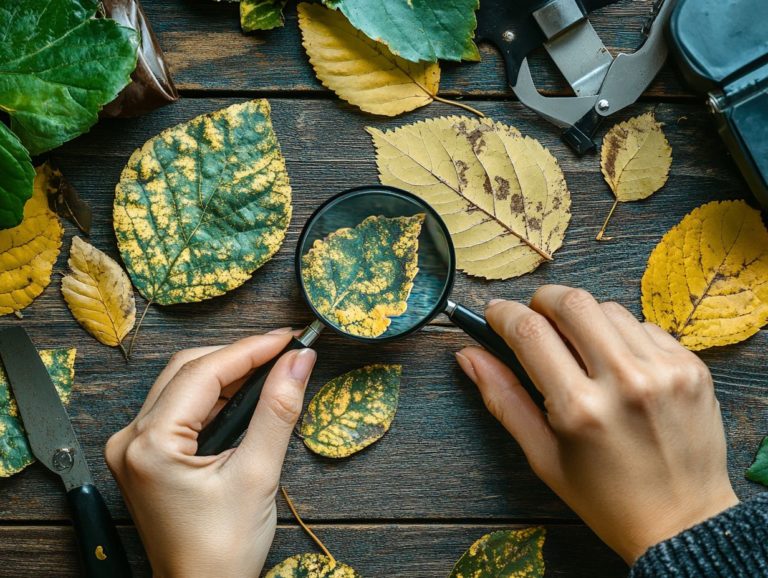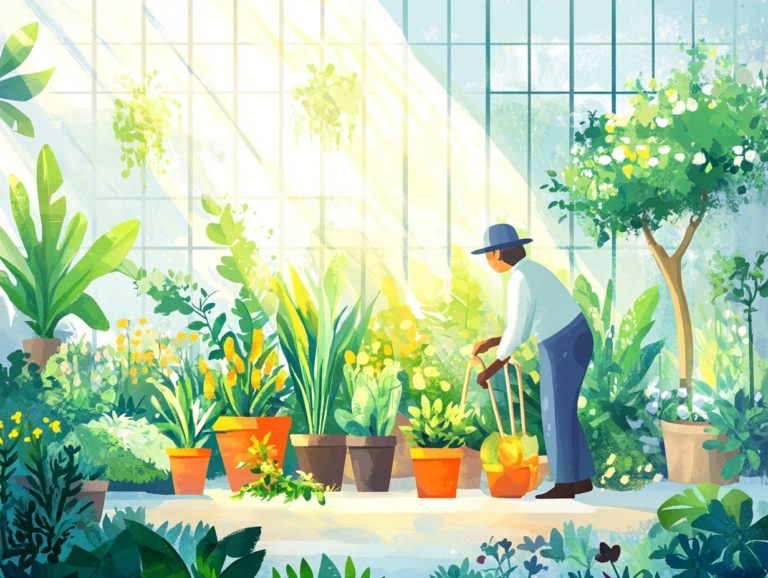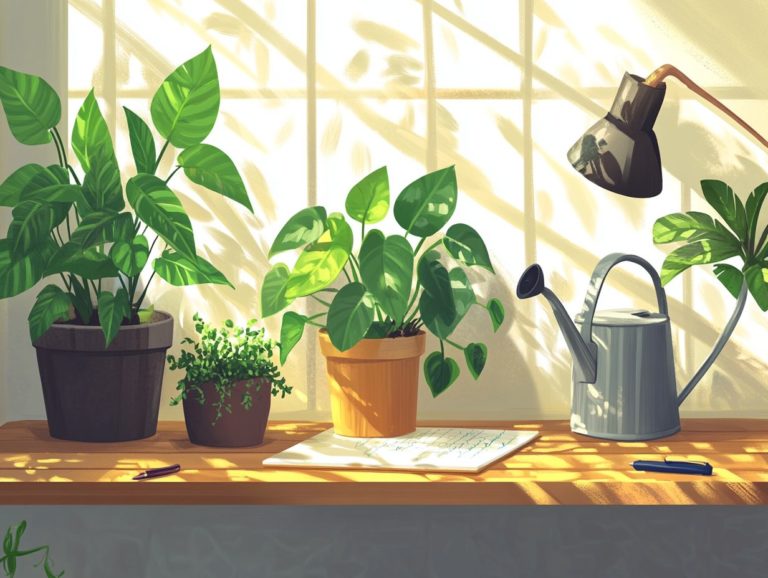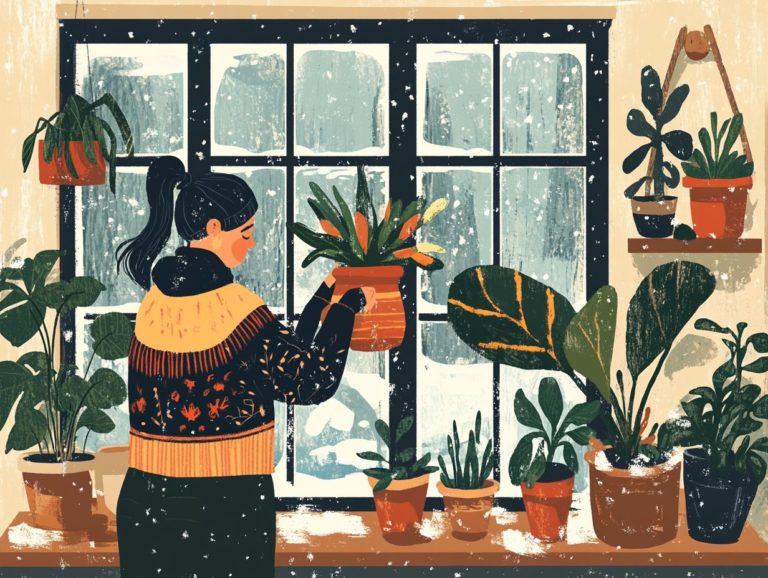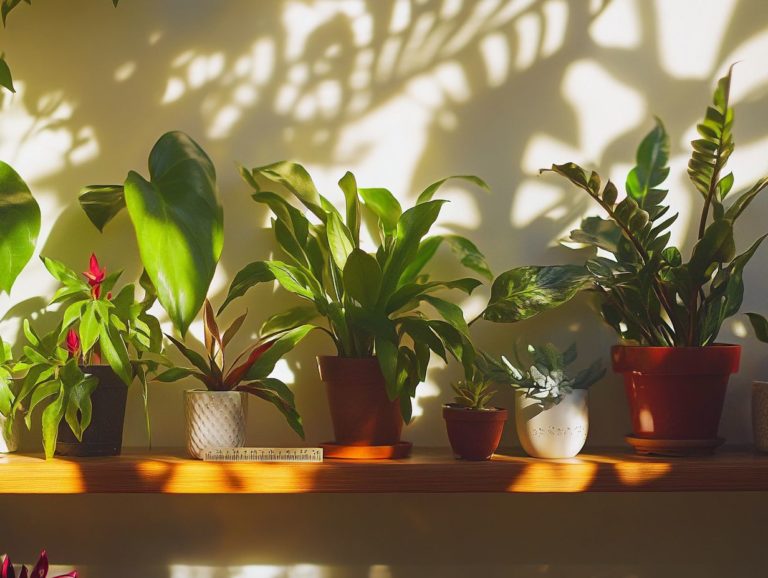How to Avoid Common Indoor Plant Problems
Indoor plants add life and vibrancy to your spaces. However, they can face challenges that may leave even the most devoted plant parents feeling exasperated.
This guide will help you identify common signs and symptoms of indoor plant issues. It explores environmental factors and pest infestations while sharing effective prevention and maintenance strategies.
With practical tips for immediate problem-solving and long-term care, you ll be fully equipped to make your indoor greenery thrive.
Contents
- Key Takeaways:
- Understanding Common Indoor Plant Problems
- Causes of Indoor Plant Problems
- Preventing Indoor Plant Problems
- Addressing Indoor Plant Problems
- Tips for Keeping Indoor Plants Healthy
- Frequently Asked Questions
- What are some common indoor plant problems to watch out for?
- How can I prevent overwatering my indoor plants?
- What are some natural ways to get rid of pests on indoor plants?
- What is root rot and how do I prevent it?
- How can I tell if my indoor plant needs more nutrients?
- What are some common mistakes to avoid when caring for indoor plants?
Key Takeaways:
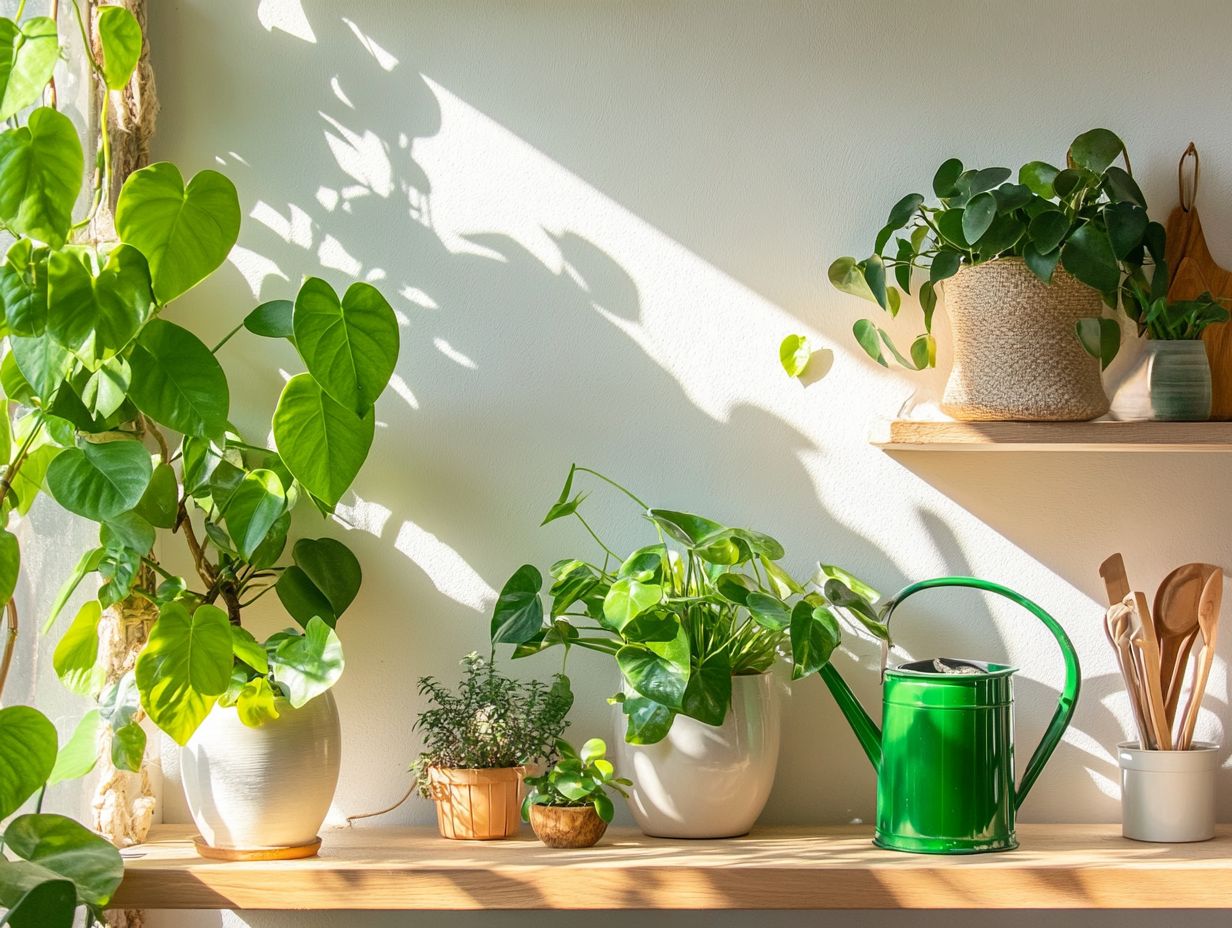
- Choose the right plants for your indoor space to prevent common problems.
- Regularly inspect and maintain your indoor plants to catch pest infestations early.
- Learn effective techniques to solve any issues that arise with your plants.
Understanding Common Indoor Plant Problems
Understanding common indoor plant problems is essential for any plant enthusiast. It helps you cultivate a thriving collection.
By familiarizing yourself with symptoms like yellowing leaves, dropping foliage, and distorted growth, you can spot issues early and take action.
Environmental factors such as sunlight exposure, humidity levels, and soil conditions significantly influence your plants health.
Recognizing these challenges boosts your pest management strategies and helps prevent diseases, keeping your houseplants healthy and vibrant.
Identifying Signs and Symptoms
Identifying signs and symptoms of plant problems is crucial for your care routine. It allows you to diagnose issues early.
Symptoms like yellowing leaves point to a lack of nutrients, especially nitrogen. Drooping plants may signal overwatering or root rot.
Pale or variegated leaves suggest insufficient sunlight, while brown edges indicate underwatering or excessive humidity.
By observing these changes, you ll better understand your plants’ needs. Timely action can rejuvenate your greenery and promote healthy growth.
Causes of Indoor Plant Problems
Understanding the causes of indoor plant problems can elevate your maintenance routine. Common issues arise from pests, environmental conditions, and improper watering practices.
Overwatering can lead to root rot, while inadequate sunlight or humidity can hinder growth and invite diseases that jeopardize your plants.
Environmental Factors
Environmental factors are key to your indoor plants health. Sunlight exposure, humidity, soil condition, and air circulation all play a role in their vitality.
Understanding how these elements interact will make you a better caregiver for your plants. For example, sunlight directly affects photosynthesis, which is vital for plant health.
Humidity levels are important for moisture absorption, especially for plants like ferns.
Managing soil conditions ensures proper drainage for better health. Good air circulation also helps keep pests away.
To enhance your plant care, consider using grow lights in low-light areas. Humidifiers or pebble trays can help maintain moisture levels, allowing your indoor gardening journey to flourish!
Combatting Pest Infestations

Pest infestations can wreak havoc on your indoor plants’ health. Pest management is an essential aspect of plant care.
Common culprits like spider mites and aphids can lead to distressing symptoms such as leaf discoloration and distorted growth. This underscores the importance of regular pest inspections.
Watch for subtle signs too. Small webs or sticky residue on leaves could indicate a serious issue that requires immediate attention.
To manage pests effectively, stay vigilant and employ remedies that are both safe and environmentally friendly. Here are some strategies:
- Neem oil, derived from the seeds of the neem tree, serves as an organic pesticide, disrupting pests’ life cycles.
- Insecticidal soap can eliminate aphids and other soft-bodied insects by suffocating them on contact.
By combining these approaches, you can cultivate a healthy, vibrant indoor garden free from pest distress. Take action now to keep your plants thriving!
Preventing Indoor Plant Problems
Preventing indoor plant problems requires a proactive strategy. Focus on meticulous plant selection and effective maintenance practices.
Choose houseplants that are well-suited to your specific environment to significantly reduce issues.
Essential care tips like increasing humidity and managing light conditions will help your plants not only survive but truly thrive.
Proper Plant Selection
Proper plant selection is vital for cultivating a thriving indoor garden, directly impacting your houseplants’ long-term success.
Understand the unique needs of various indoor plants regarding environmental factors, nutrient requirements, and overall care.
Consider crucial aspects like light levels and humidity when choosing houseplants. Some plants bask in bright, direct sunlight, while others prefer the gentler embrace of indirect light.
Assess your home’s humidity levels; certain species, such as ferns and tropical plants, thrive in humid conditions, while succulents and cacti prefer drier environments.
By examining these factors and selecting varieties accordingly, you ll set the stage for vibrant, resilient plants that require minimal intervention. Enjoy the beauty they bring!
Effective Maintenance Practices
Implementing effective maintenance practices is essential for the long-term health and beauty of your indoor plants. Regular watering, leaf cleaning, and monitoring root health are vital components of plant care.
Establish a consistent watering schedule based on each plant’s specific needs. Over or under-watering can lead to detrimental effects, so staying attentive is key.
Cleaning the leaves enhances their appearance and boosts plants’ ability to use sunlight for food.
Check root health by gently lifting the pot. This can reveal signs of rot or overcrowding, allowing timely action that boosts overall vitality. To avoid common pitfalls, be aware of the top 7 mistakes in watering indoor plants. Follow these simple practices to create a stunning indoor garden filled with vibrant greens!
Addressing Indoor Plant Problems
Promptly addressing indoor plant problems can be the decisive factor between recovery and irreversible damage. Use effective problem-solving techniques like pest identification and recognizing the signs of plant disease for successful treatment.
This approach is crucial for challenges like root rot and fungal diseases. Act quickly to save your plants!
Problem-Solving Techniques
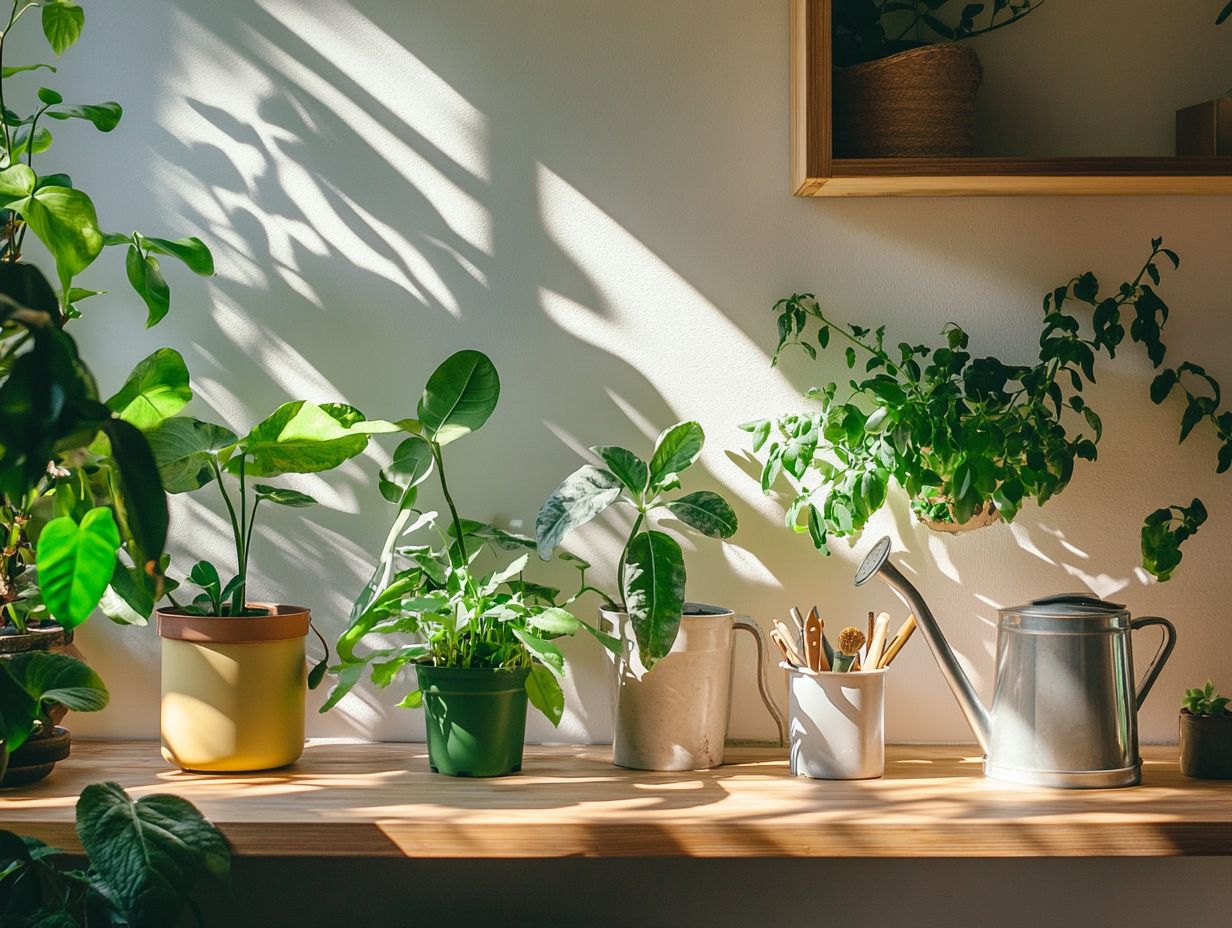
Utilizing effective problem-solving techniques is crucial for maintaining the health of your indoor plants! When you encounter issues like pest infestations or root health challenges, understanding various treatment options allows you to act swiftly and minimize potential damage.
Being attuned to early signs of distress such as yellowing leaves or unexpected spots enables you to diagnose potential issues before they escalate. Tools like sticky traps are particularly effective for identifying pest problems. Additionally, examining soil moisture levels provides valuable insights into root health.
Implement simple pest control methods, like introducing natural predators and using organic treatments. Regularly checking for mold or fungal growth beneath your plant leaves helps you intervene promptly, keeping your plants vibrant and healthy! Additionally, understanding how to water your indoor garden correctly is crucial for their overall health.
Tips for Keeping Indoor Plants Healthy
Maintaining the health of your indoor plants requires a thoughtful blend of best practices and continuous learning about their unique needs. By following established plant care guidelines, like effective watering techniques and enhancing humidity, you create an environment that nurtures and supports thriving houseplants.
Best Practices for Long-Term Plant Care
Adopting best practices for long-term plant care is essential for cultivating a sustainable indoor gardening experience. Follow consistent watering tips, manage pests proactively, and understand your plants’ unique nutrient needs to foster a thriving green sanctuary!
Your watering schedule should vary depending on the specific type of plant. For instance, succulents flourish with less frequent watering, while tropical varieties often prefer a more regular hydration routine. Always assess the moisture level of the soil before watering to avoid over-saturation that could lead to root rot!
You should also apply organic nutrients during the growing season to enhance your plants vitality, as different species have distinct nutrient requirements. Implementing integrated pest management techniques like using neem oil or introducing beneficial insects protects your plants from pests without harsh chemicals, allowing your indoor garden to flourish safely and beautifully!
Frequently Asked Questions
What are some common indoor plant problems to watch out for?
- Overwatering
- Pests
- Root rot
- Lack of nutrients
How can I prevent overwatering my indoor plants?
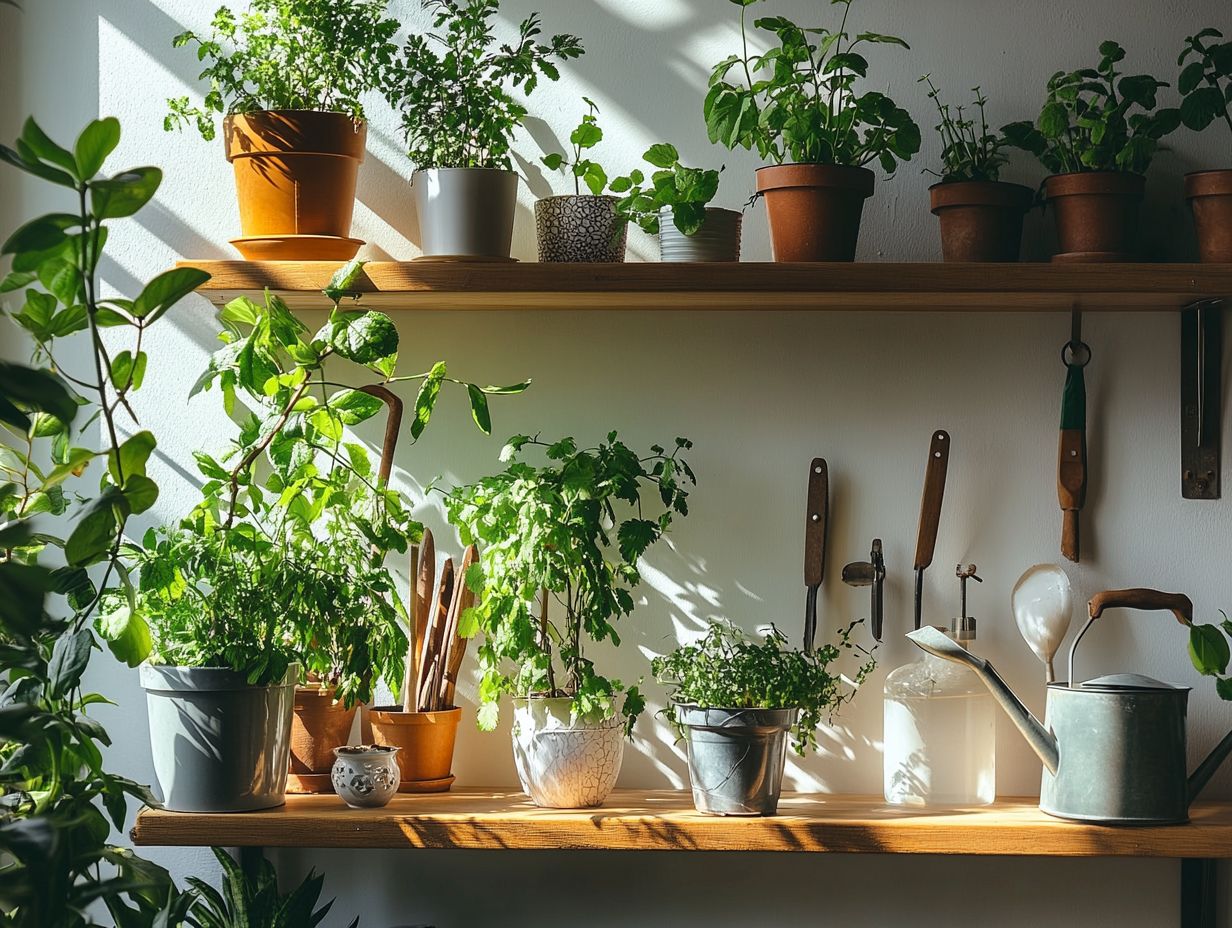
To avoid overwatering, always check the moisture level of the soil before watering and only water when the top inch of soil is dry. Ensure your plant has proper drainage and is not sitting in water!
What are some natural ways to get rid of pests on indoor plants?
Use a mild soap and water mixture to gently wipe off pests on your plants. Introducing natural predators, such as ladybugs, can help control pest populations effectively!
What is root rot and how do I prevent it?
Root rot is a fungal disease that occurs when the roots of a plant become waterlogged and lack oxygen. To prevent root rot, ensure your plant has proper drainage and only water when the soil is dry.
How can I tell if my indoor plant needs more nutrients?
If your plant’s leaves are yellowing or its growth is stunted, it may indicate a need for more nutrients. Use a balanced fertilizer to provide your plants with what they need!
What are some common mistakes to avoid when caring for indoor plants?
Common mistakes to avoid include:
- Over or under watering
- Not providing enough light
- Neglecting to repot when needed
- Failing to check for pests regularly
Research your plants’ specific needs and regularly check on their health to avoid these common pitfalls!
Act now to implement these tips and watch your indoor garden thrive! Share your experiences with plant care in the comments below!


